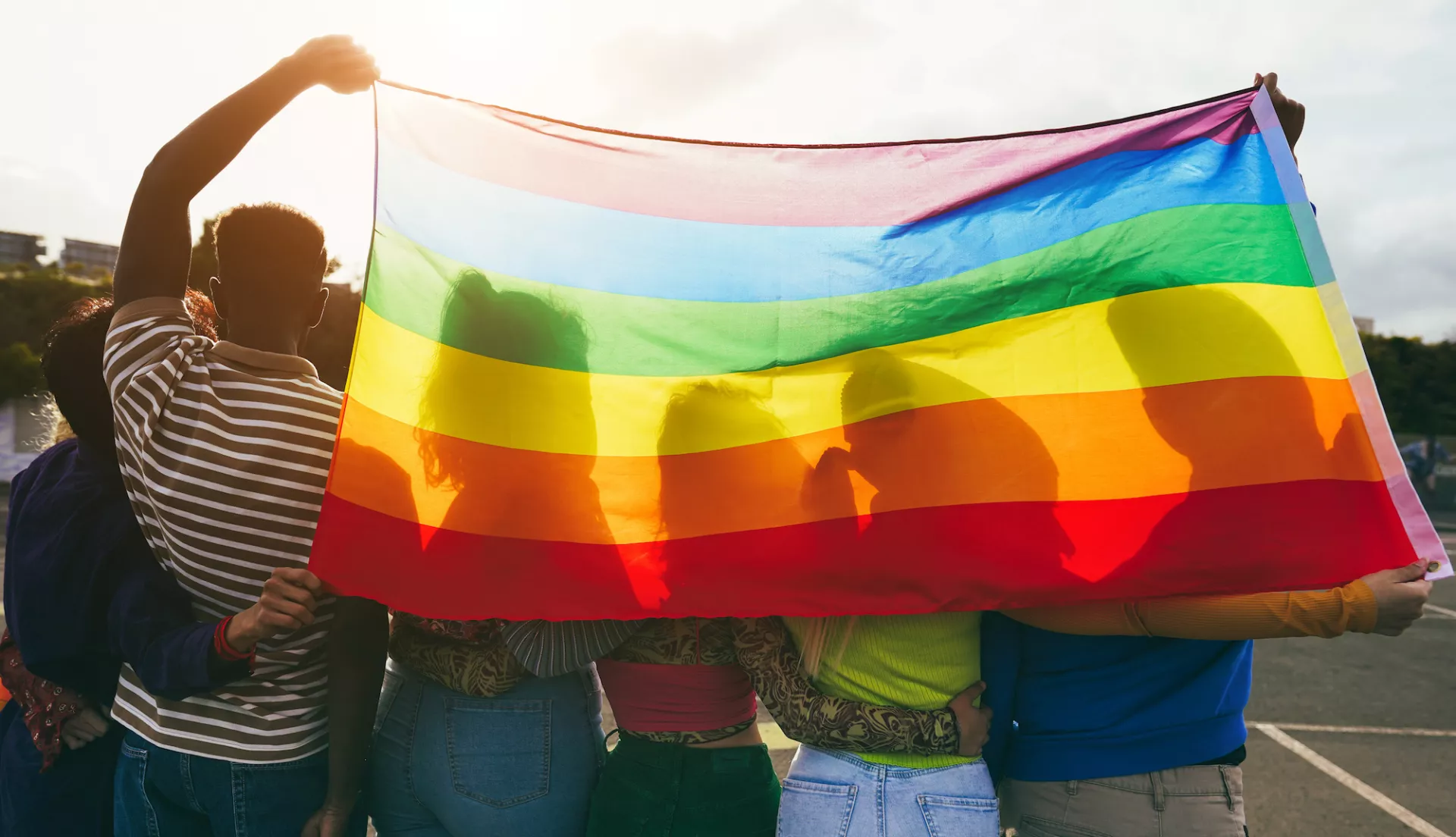
Key Takeaways
- A supportive school community can mean the difference between life and death for LGBTQ+ students—those who say their schools are LGBTQ+ affirming are less likely to attempt suicide.
- Educators can help LGBTQ+ students feel supported by understanding the law, using inclusive language, addressing harmful comments, amplifying voices, and using the new NEA toolkit for supporting and protecting LGBTQ+ students.
- The new toolkit includes info about educator and students' rights, NEA's guide to pronouns, welcoming art for your classroom, and links to email your congressional representatives to ask them to support the Equality Act.
“It’s scary to be a queer person,” says Amber Ingram, a New Jersey ESL teacher. “It’s scary to think about all of the queer kids that are experiencing this hate from people that just don’t understand who they are.”
Over 500 anti-LGBTQ+ bills have been introduced by state legislatures in 2023. These bills would ban curriculum related to LGBTQ+ identity, ban gender affirming care for youth, criminalize parents supporting their children, put transgender students’ safety on the line—and endanger all LGBTQ+ students.
In Florida, for example, lawmakers passed a measure targeting trans people by requiring all individuals in government buildings to use bathrooms that align with their sex assigned at birth. Anyone who violates this law could face trespassing charges. In Tennessee, a new law prohibits public schools and colleges from requiring implicit bias training. In Montana, Senate Bill 458 created a statewide, anti-LGBTQ+ definition of “sex.”
These measures—and many others—impact the safety and wellness of our LGBTQ+ youth who desperately need community support.
A 2022 national survey of nearly 34,000 LGBTQ+ youth, ages 13-24, paints a clear, distressing picture of the trauma endured by LGBTQ+ students in America. Nearly three-quarters reported symptoms of anxiety; 58 percent reported symptoms of depression; and 45 percent said they had seriously considered committing suicide within the past year.
However, the survey also shows that educators can make a very big difference. LGBTQ+ youth who found their school to be affirming reported lower rates of suicide attempts and suicidal ideation.
With that in mind, here are five things educators can do to help support LGBTQ+ students:
1. Understand the Law

“I have educator friends across the country [who] are trying to toe the line between what they can say and what they can't say without literally losing their jobs,” says Ingram.
In order to protect themselves and their jobs, while still uplifting students, educators should familiarize themselves with state laws.
Tami Staas is a third-grade International Baccalaureate teacher and the executive director of the Arizona Trans Youth and Parent Organization. She explains that amidst all of the new anti-LGBTQ+ legislation being introduced, it is important for educators to know how they can legally advocate for their students.
“In the wake of all this anti-LGBTQ+ legislation, we're seeing a lot of those laws weaponized against us and I'm hearing a lot of mistruths,” says Staas.
At a recent webinar for the Arizona Education Association, a participant approached Staas with a simple, yet alarming question: Is it legal to hang a rainbow flag in an Arizona classroom? The participant’s superintendent had told them it was against the law.
“I said, ‘No, it's perfectly legal. There's no law against that,’” Staas says. “Knowing what's legal and knowing what's not is really important…There's a lot of ambiguity in [anti-LGBTQ+ laws] and a lot of confusion around them.”
Keep in mind that districts may have policies prohibiting certain types of classroom displays, and educators should always seek clarification from their administration and their local or state association. Many of these laws are intentionally vague and meant to create a climate of fear and self-censorship, even about signs of support that are not prohibited. Knowledge of rights is crucial.
In an alarmingly anti-LGBTQ+ environment, reading legislation can be helpful in knowing what rights educators have in their classroom. It is also important to use available resources and ask questions. Organizations like the Gay, Lesbian and Straight Education Network (GLSEN) and your local and state NEA affiliates are there to help.
2. Use Inclusive Language
The key to making children feel included in the conversation is language and intent, says Staas.

“Look at any school mission statement and it says ‘all kids, everyone’ and when we talk about everyone, we have to include the LGBTQ+ kids,” says Staas. “By using inclusive language, we kind of set that environment where they're able to feel more comfortable.”
Staas suggests avoiding binary-restricting directions and language. For example, educators should not divide the class into “boy” and “girl” groups or lines. Instead, divide by shirt color, randomly generate groups, or even let students choose.
Similarly, Ingram is making strides to normalize inclusive language and pronouns. For instance, she uses “they” and “them” to refer to individuals when she may not know their preferred pronouns. Ingram also displays her pronouns in all spaces—an easy way to make students more comfortable sharing their own.
3. Address Harmful Comments
Regardless of political or religious beliefs, classrooms should be a safe space for all students. That is why Ingram suggests addressing harmful language and comments in an open and honest conversation.
“Just kind of attack it head on—not from a place of calling a student out, but just kind of examining why they said that or where it's coming from—so I know my students who are queer feel safe in that space,” says Ingram.
Staas was once approached by a fifth-grade teacher asking for advice on a student who had begun transitioning, using a different name and pronouns within her classroom.
“[The fifth grade teacher] said some of the kids were basically saying, ‘I don't get it. I'm not going to do that,’” says Staas. “So I counseled her to have a classroom discussion.”
Staas suggested her colleague tell students that they don’t have to understand, but they should try their best to display respect and kindness.
“What we're asking you to do is be kind,” says Staas. “Empathy doesn't mean endorsement.”
4. Amplify Voices
Rather than arguing about student experiences and autonomy, educators and legislators alike must take a step back and listen to the voices of student’s being impacted.
“Give them a platform,” Staas suggests. “Give them the microphone. Make them feel comfortable speaking their truth. If you’re setting up that classroom where it’s a safe space, and they know it’s a safe space, they’re going to use their voices. That’s going to help and that’s going to go a long way.”

Sam Long, a Colorado high school teacher, is an advocate for LGBTQ+ inclusion in curriculum and standards. He explains that educator representation and voice also plays an important role in student’s comfortability.
“Every child deserves to have teachers who share their experiences and identities because these adults provide hope and proof that a fulfilling life is possible,” writes Long. “For our growing number of trans and nonbinary and questioning students, I get to be that proof.”
One additional suggestion? “ Look for moments of joy,” says Staas. “Look for the celebrations, because there's so much that is so negative. Looking for those moments of happiness and joy, tends to break up that negativity.”
5. Use the NEA Toolkit!
Our LGBTQ+ students need us to ensure our schools are places where all students are protected and empowered. The new NEA toolkit includes resources on what educators should know about federal protections for educators and students; how to create an inclusive space; and more.
Find out about available educator trainings, check out NEA's LGBTQ+ book list, and download welcoming art for your classroom. You also can read NEA's pronoun guide, email your congressional representatives to ask them to support the Equality Act, and sign the NEA pledge to stand against hate and bias.
